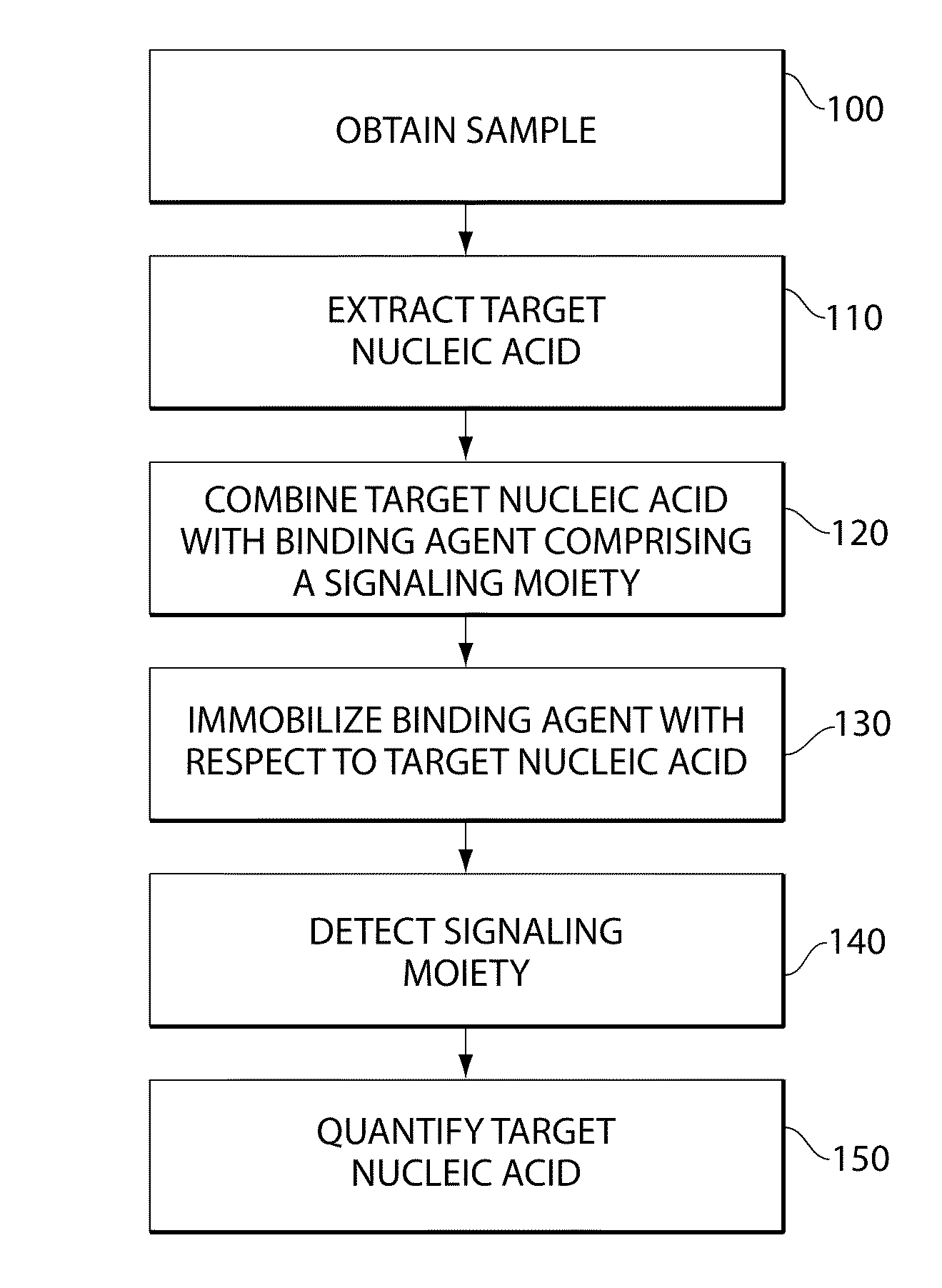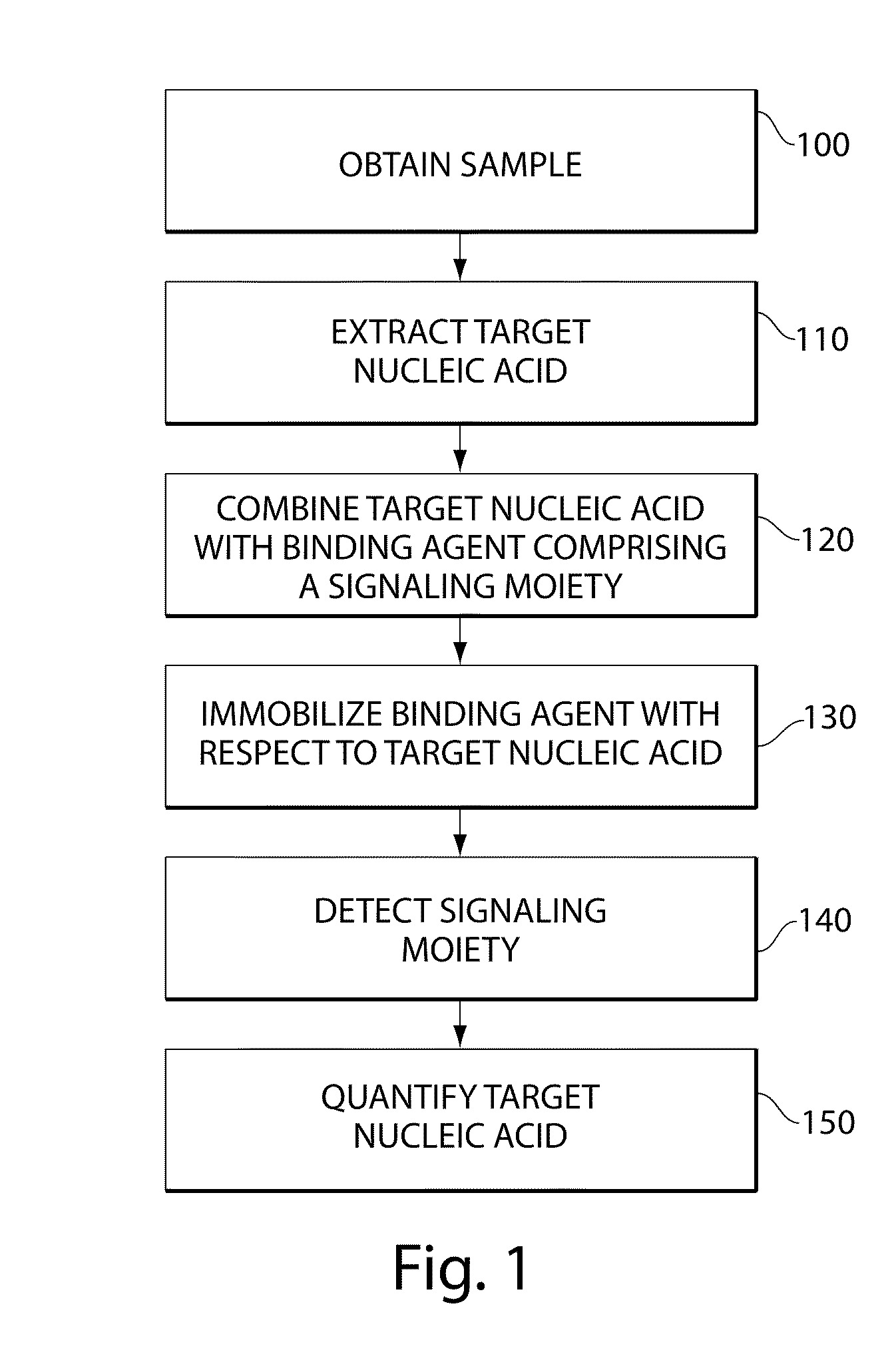Methods for forensic DNA quantitation
a forensic and dna technology, applied in the field of microfluidic methods and devices for nucleic acid quantification, can solve the problems of allele dropout, imbalance of allele peak height, and artifacts including
- Summary
- Abstract
- Description
- Claims
- Application Information
AI Technical Summary
Problems solved by technology
Method used
Image
Examples
example 1
[0148]This example describes the system used in the examples below.
[0149]The system comprises an instrument for separation and detection of labeled DNA fragments and is described in more detail in U.S. Patent Application Publication No. 2009 / 0023603, entitled “Methods for Rapid Multiplexed Amplification of Target Nucleic Acids,” filed Apr. 4, 2008, by Selden et al., which is incorporated herein by reference. The instrument is ruggedized for field and laboratory use, has low power consumption, and is CE marked under the Low Voltage Directive 73 / 23 / EEC. DNA separation takes place within a 16 sample biochip and custom sieving matrix by applying appropriate loading, pullback, and separation voltages through a high voltage subsystem. A laser induced fluorescence detection subsystem excites and collects fluorescence from the labeled DNA fragments that pass through the excitation and detection zone of the biochip. Separations carried out by applying a 150 V / cm and 300 V / cm electric field a...
example 2
[0160]This example demonstrates DNA quantification by microfluidic Picogreen assay using a TH01 locus probe.
[0161]An injection molded 16-lane biochip with optically clear reaction chambers was fabricated to allow interrogation of the reaction products with the optical system described above. Each lane in the biochip holds approximately 7 μL reaction mix and allows amplification of 16 individual samples simultaneously. PCR conditions were carried out as previously described (Giese et al., “Fast Multiplexed PCR for Conventional and Microfluidic STR Analysis.” (2009) J. Forensic Sci. Vol. 54, Issue 6, pages 1287-1296). The primer pairs used to target the single-copy human tyrosine hydroxylase gene, TH01 (Swango et al., “Developmental validation of a multiplex qPCR assay for assessing the quantity and quality of nuclear DNA in forensic samples.” (2007) Forensic. Sci. Int. Vol. 170, Issue 1, pages 35-45), were:
[0162]
TH01 Forward Primer:5′- AGG GTA TCT GGG CTC TGG -3′(SEQ ID NO: 1)TH01 Re...
example 3
[0171]This example demonstrates DNA quantification by microfluidic picogreen assay using an Alu locus probe.
[0172]The use of a repetitive locus for quantification may allow further reduction in reaction time and improvement in LOD. Human Alu sequences are repetitive elements that are present in hundreds of thousands of copies in the genome, and a primer pair targeting Alu sequences was used for microfluidic quantification:
[0173]
(SEQ ID NO: 3)Alu Forward Primer:5′ -GTC AGG AGA TCG AGA CCA TCC C- 3′(SEQ ID NO: 4)Alu Reverse Primer:5′ -TCC TGC CTC AGC CTC CCA AG- 3′
Fast PCR cycling profile reactions and quantification were as described in Example 2 with a modified amplification protocol of 20 seconds activation at 93° C. followed by 15-cycles of [93° C. for 4 seconds, 58° C. for 15 seconds, 70° C. for 7 seconds] and final extension for 90 seconds at 70° C. Completion time was approximately 10 minutes. A plot of input DNA versus relative fluorescence units (RFU) from the instrument has ...
PUM
| Property | Measurement | Unit |
|---|---|---|
| concentration | aaaaa | aaaaa |
| concentration | aaaaa | aaaaa |
| diameter | aaaaa | aaaaa |
Abstract
Description
Claims
Application Information
 Login to View More
Login to View More - R&D
- Intellectual Property
- Life Sciences
- Materials
- Tech Scout
- Unparalleled Data Quality
- Higher Quality Content
- 60% Fewer Hallucinations
Browse by: Latest US Patents, China's latest patents, Technical Efficacy Thesaurus, Application Domain, Technology Topic, Popular Technical Reports.
© 2025 PatSnap. All rights reserved.Legal|Privacy policy|Modern Slavery Act Transparency Statement|Sitemap|About US| Contact US: help@patsnap.com



